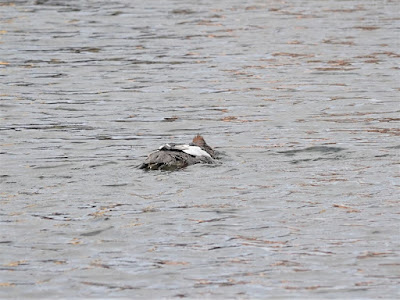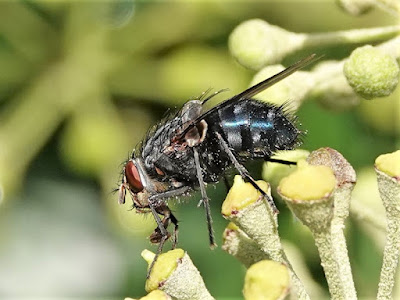7.0°C > 9.0°C: Broken medium-level cloud with several light showers. Light west-north-west wind. Excellent visibility.
Sunrise: 07:33 BST
+ = my first sighting of this species at this site this year.
++ = new species for me at this site.
* = a species photographed today
Highlight was the start of the Wood Pigeon migration. That said I saw no movement of any winter thrushes (Fieldfare or Redwing).
Priorslee Balancing Lake: 05:50 – 09:30
+ = my first sighting of this species at this site this year.
++ = new species for me at this site.
* = a species photographed today
Highlight was the start of the Wood Pigeon migration. That said I saw no movement of any winter thrushes (Fieldfare or Redwing).
Priorslee Balancing Lake: 05:50 – 09:30
(211th visit of the year)
Bird notes:
- a sub-adult and a first year Mute Swan arrived together. They were soon chased away with the sub-adult leaving to the West (and seen at The Flash later?); and the first-year, a recently fledged cygnet, leaving several minutes later to the East.
- rather few gulls this morning. Just 24 Black-headed (and one first winter Herring) on the football field with no more than 25 Black-headed Gulls elsewhere on the water. A lone Lesser Black-backed was all that appeared around dawn. Fewer than usual later.
Counts of birds noted flying over:
- 22 Feral Pigeon: a trio and ten East; nine together West
- 2 Stock Doves: duo
- 424 Wood Pigeons: of these 304 were in eight migrant groups flying South
- 1 Herring Gull
- 10 Lesser Black-backed Gulls
- 5 Cormorants: a duo and a trio
- 1 Grey Heron
- 199 Jackdaws
- 111 Rooks
- 9 Pied Wagtails
- 1 Siskin
Warblers noted (the number singing in brackets):
- 1 (1) Cetti's Warbler
- 2 (0) Chiffchaffs
Counts from the lake area:
- 7 Canada Geese: a duo arrived at 06:50 and left at 07:05; five arrived at 07:40
- 4 + *3 Mute Swans: see notes
- 1 (1♂) Gadwall: flew off with...
- 1 (1♂) Mallard
- 3 (0♂) Tufted Duck
- 4 Moorhens
- 122 Coots
- 2 Great Crested Grebes
- c.50 Black-headed Gulls
- 4 Herring Gulls
- 12 Lesser Black-backed Gulls
- 1 Cormorant: arrived
On or around the street lamp poles at dawn:
Moths:
- none
Other things:
- 6 Spotted-winged Drosophila flies (Drosophila suzukii)
- *1 cranefly Limonia nubeculosa
- *1 wood gnat, perhaps Sylvicola fenestralis
- *1 other wood gnat sp.
- 1 male plumed midge Chironomus plumosus
- *1 probable larva from an Agromyzidae fly
- *1 Muscid fly Phaonia subventa
- 1 springtail Pogonognathellus longicornis
- *1 spider Neriene montana
- 1 harvestman Dicranopalpus ramosus/caudatus
- 1 harvestman Paroligolophus agrestis
Noted later:
- cranefly Tipula oleracea
- *cranefly Tipula pagana
I could not even find an Alder Leaf Beetle!
A shower threatening from the North as the sun rises.
The first winter Mute Swan visitor leaves. The plumage indicates it was born this year and is well-advanced compared with the cygnets here and at The Flash that have very recently started to fly only short distances.
A cranefly Limonia nubeculosa doing better than some other craneflies I have photographed recently: it has only lots one leg.
A cranefly in daytime: Tipula pagana.
This is a wood gnat, perhaps Sylvicola fenestralis. There are several similar species that occur less frequently. Separation requires detailed examination of the wing venation.
This looks to be a different species of wood gnat with unpatterned wings and a larger head. This structure suggests one of the Bibio species of fly. However they are all Spring- and early Summer-flying insects. Unresolved and certainly not a species of Gymnosoma or balloon fly as suggested by my app.
The Obsidentify was not specific about this, with 16% suggestion that it was a Phytomyza sp. "A what" I hear you ask. This genus is part of the fly family Agromyzidae. Reference to NatureSpot website finds a photo of a similar looking larva from this group. It was clearly sliding across the street lamp pole though I don't think it was leaving a slime-trail like a slug, just ploughing through the dew droplets. The front is top left (unless it was proceeding backwards!).
It is unusual for me to see a 'full size' fly on the street lamp poles pre-dawn. This Muscid fly Phaonia subventa was an exception today.
A spider Neriene montana.
(Ed Wilson)
Note
A rare sighting of a Smew en masse this morning 8.30 am on The Flash.
Gone this evening.
Pair of Heron nesting in N.E. Corner.
Cormorant perching this evening edge of the island on The Flash.
(Ann Dewhurst)
------------------------------------------------------------------------------------------------------
The Flash: 09:35 – 10:35
(197th visit of the year)
Bird notes:
- a third white Mute Swan present and being pursued by the resident cob. Perhaps the bird that visited the Balancing Lake earlier. At the lake it soon got the message and left: here it stayed a few yards ahead. Could it perhaps be the third bird from last winter that was taken in to care during the Summer?
- *I was able to get a blurred but adequate photo to confirm the presence of two Common Teal on the edge of the island.
- the unexpected Blackcap was calling again from near the reeds alongside Derwent Drive.
Bird(s) noted flying over here:
- 1 Sparrowhawk
- 2 Skylarks
- 2 Jackdaws
Warblers noted:
- 1 (0) Blackcap
Noted on / around the water:
- 3 Canada Geese
- *3 + 4 Mute Swans: see notes
- *29 (18♂) Mallard
- 1 (1♂) all-white feral duck
- *2 (0♂?) Common Teal
- 21 (10♂) Tufted Duck
- *49 brownhead Goosander
- 18 Moorhens
- 34 Coots
- *4 + 2 (1 brood) Great Crested Grebes
- 8 Black-headed Gulls
Noted on / beside the street lamp poles etc. around the water etc.:
- 2 Alder Leaf Beetles (Agelastica alni)
Noted elsewhere around The Flash:
Butterflies:
- Red Admiral (Vanessa atalanta)
Bees / wasps etc.:
- Common Wasp (Paravespula vulgaris)
Hoverflies:
- Marmalade Hoverfly (Episyrphus balteatus)
- *Common Dronefly (Eristalis tenax)
Other flies:
- many including probable *Common Blow Fly (Calliphora vicina)
Fungus:
- *Mycena sp. (species of "bonnet")
The resident cob Mute Swan on the war-path and chasing the interloper.
It may look like a duck Mallard but not with a bill that colour it isn't. I suspect this is one of the four erstwhile ducklings, now almost fully grown and beginning to show which sex they are. Male (drake) in this instance.
I know, I know, a rubbish (super-enlarged) photo. But it is just possible to make out green in the folded wings of these two ducks identifying them as Common Teal.
As this brownhead Goosander crouched with its head in the water there seemed to be much white in the wing.
Indeed there was. The white area extends across the breadth of the wing and this bird is therefore a drake.
Just showing off! Looking rather soggy in places.
An adult Great Crested Grebe has been fishing.
I assumed it was going to take the fish to the youngster begging the other adult. Not so. It powered straight past!
I know it looks somewhat 'tapered' but not enough to be a Tapered Drone Fly (Eristalis pertinax). It is 'just' a Common Dronefly (E. tenax).
There were many flies and wasps and not too many hoverflies on the Ivy bank. This splendidly nasty-looking fly is a probable Common Blow Fly (Calliphora vicina). I am always surprised by the length of the tongue on many insects.
Not a very helpful suggestion from my app. for this small fungus growing out of the trunk of a large tree. "Mycena sp." This refers to many very similar "bonnets" and was as far as it was prepared to go. I cannot add to that.
(Ed Wilson)
------------------------------------------------------------------------------------------------------
On this day can be found via the yearly links in the right-hand column.
2011
Priorslee Lake
14 Redwing
(Glenn Bishton)
2010
Priorslee Lake
1 Wigeon
2nd winter Common Gull
Redpoll
(Ed Wilson)
2009
Priorslee Lake
54 Mute Swans
3 Wigeon
6 Pochard
12 Tufted Ducks
15+ Lapwings
203 Coots
Meadow Pipit
3 Skylarks
1 Siskin
6 Redwing
Willow Tits
(Ed Wilson)
2006
Priorslee Lake
2 Cormorant
Water Rail
Lapwings
37 Robins
21 Blackbirds
1 Fieldfare
6 Song Thrushes
48 Redwings
Siskin
300 Starlings
(Ed Wilson)



















